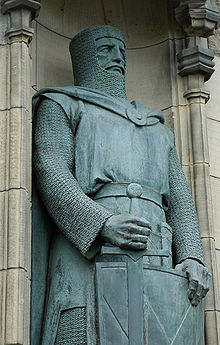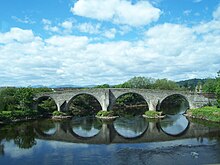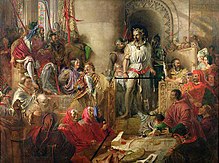William Wallace
William Wallace | |
|---|---|
 Depiction of Wallace in a stained glass window in the Wallace Monument | |
| Guardian of the Kingdom of Scotland (Second Interregnum) | |
| In office 1297–1298 | |
| Preceded by | John Balliol (as King of the Scots) |
| Succeeded by | |
| Personal details | |
| Born | c. 1270 Marion Braidfute[1] (disputed) |
| Children | None recorded |
| Occupation | Military leader |
| Military service | |
| Allegiance | |
| Years of service | 1297–1305 |
| Rank | Commander |
| Battles/wars | |
Sir William Wallace (
Along with
Since his death, Wallace has obtained a legendary status beyond his homeland. He is the
Background

William Wallace was a member of the lesser nobility, but little is definitely known of his family history or even his parentage. William's own
The origins of the
Military career
Political crisis in Scotland

When Wallace was growing up, King
With Scotland threatening to descend into civil war, King
Edward proceeded to take steps to progressively undermine John's authority, treating Scotland as a feudal vassal state, demanding homage be paid towards himself and military support in his war against France—even summoning King John Balliol to stand before the English court as a common plaintiff. The Scots soon tired of their deeply compromised king, and the direction of affairs was allegedly taken out of his hands by the leading men of the kingdom, who appointed a Council of Twelve—in practice, a new panel of Guardians—at Stirling in July 1295. They went on to conclude a treaty of mutual assistance with France—known in later years as the Auld Alliance.[22]
In retaliation for Scotland's treaty with France, Edward I invaded, storming Berwick-upon-Tweed and commencing the Wars of Scottish Independence. The Scots were defeated at Dunbar and the English took Dunbar Castle on 27 April 1296.[23] Edward forced John to abdicate, which he did at Stracathro near Montrose on 10 July 1296.[24] Here the arms of Scotland were formally torn from John's surcoat, giving him the abiding name of "Toom Tabard" (empty coat). By July, Edward had instructed his officers to receive formal homage from some 1,800 Scottish nobles (many of the rest being prisoners of war at that time).[25]
Silent years prior to the Wars of Independence
Some historians[ so he may have fought as an archer in Edward's army.
Walter Bower's mid-15th century Scotichronicon, states that Wallace was "a tall man with the body of a giant ... with lengthy flanks ... broad in the hips, with strong arms and legs ... with all his limbs very strong and firm".[28] Blind Harry's late 15th century poem The Wallace, asserts Wallace reached seven feet.[29]
Start of the uprising

The first act definitely known to have been carried out by Wallace was his
The uprising suffered a blow when the nobles submitted to the English at
Battle of Stirling Bridge

On 11 September 1297, an army jointly led by Wallace and Andrew Moray won the Battle of Stirling Bridge. Although vastly outnumbered, the Scottish army routed the English army. John de Warenne, 6th Earl of Surrey's feudal army of 3,000 cavalry and 8,000 to 10,000 infantry met disaster as they crossed over to the north side of the river. The narrowness of the bridge prevented many soldiers from crossing together (possibly as few as three men abreast), so, while the English soldiers crossed, the Scots held back until half of them had passed and then killed the English as quickly as they could cross.[32] The infantry were sent on first, followed by heavy cavalry. The Scots' schiltron formations forced the infantry back into the advancing cavalry. A pivotal charge, led by one of Wallace's captains, caused some of the English soldiers to retreat as others pushed forward, and under the overwhelming weight, the bridge collapsed, and many English soldiers drowned. Thus, the Scots won a significant victory, boosting the confidence of their army. Hugh de Cressingham, Edward's treasurer in Scotland, died in the fighting and it is reputed that his body was subsequently flayed, and the skin cut into small pieces as tokens of the victory. The Lanercost Chronicle records that Wallace had "a broad strip [of Cressingham's skin] ... taken from the head to the heel, to make therewith a baldrick for his sword".[33][34]
After the battle, Moray and Wallace assumed the title of Guardians of the Kingdom of Scotland on behalf of King John Balliol. Moray died of wounds suffered on the battlefield sometime in late 1297.[34]
Wallace soon mounted an invasion of northern England, crossing into Northumberland. The Scots army followed the English army fleeing south. Caught between two armies, hundreds of refugees fled to safety behind the walls of Newcastle. The Scots laid waste a swathe of countryside before turning west into Cumberland and pillaging all the way to Cockermouth, before Wallace led his men back into Northumberland and fired 700 villages. Wallace then returned from England laden with booty.[4]
In a ceremony, at the 'Kirk o' the Forest' (
]Battle of Falkirk
In April 1298, Edward ordered a second invasion of Scotland. Two days prior to the battle 25,781
Wallace arranged his spearmen in four
By September 1298, Wallace resigned as Guardian of Scotland in favour of Robert the Bruce, Earl of Carrick and future king, and John Comyn, King John Balliol's nephew.[42][41]
Details of Wallace's activities after this are vague, but there is some evidence that he left on a mission to the court of King Philip IV of France to plead the case for assistance in the Scottish struggle for independence. There is a surviving letter from the French king dated 7 November 1300 to his envoys in Rome demanding that they should help Sir William.[43] It also suggests that Wallace intended to travel to Rome, although it is not known if he did.[44] There is also a report from an English spy at a meeting of Scottish leaders, where they said Wallace was in France.[45]
By 1304 Wallace was back in Scotland and involved in skirmishes at
Capture and execution

Wallace evaded capture by the English until 5 August 1305, when
Wallace was transported to London and taken to

Following the trial, on 23 August 1305, Wallace was taken from the hall to the
In 1869, the Wallace Monument was erected, close to the site of his victory at Stirling Bridge. The Wallace Sword, which supposedly belonged to Wallace, although some parts were made at least 160 years later, was held for many years in Dumbarton Castle and is now in the Wallace Monument.[54]
In popular culture
Film
- A popular depiction of Wallace's life is presented in the film Braveheart (1995), directed by and starring Mel Gibson as Wallace, written by Randall Wallace, and filmed in Scotland and Ireland. The film was criticised for many historical inaccuracies.[55][56]
- In the film Outlaw King (2018), Robert the Bruce (Chris Pine) is prompted to plan a revolt against the English after observing rioting induced by the public display of the quartered body of Wallace.[57]
Literature
- Blind Harry's 15th-century poem has been a major influence on the legend of Wallace, including details like a wife named Marion Braidfute, and claiming that Wallace killed the Sheriff of Lanark in revenge for the killing of his wife. However much of this poem is unsubstantiated, at variance with contemporary sources, or disputed by historians.[58]
- In 1793, Robert Burns wrote the lyrics to Scots Wha Hae wi Wallace bled.[59]
- The Scottish Chiefs (1810).[60]
- In her prize-winning poem of 1819, Wallace's Invocation to Bruce, Felicia Hemans imagines Wallace urging Bruce to continue the struggle for freedom after defeat at the Battle of Falkirk.
- In 1828, Walter Scott wrote of "The Story of Sir William Wallace" in his Tales of a Grandfather (first series).[61]
- Boy's Own Paper story paper, portrays the life of William Wallace, Robert the Bruce, The Black Douglas and others, while dovetailing the events of his novel with historical fiction.[62]
- Nigel Tranter wrote a historical novel titled The Wallace (1975), "admirably free of anything to do with Braveheart".[63]
- The Temple and the Stone (1998), a novel by Katherine Kurtz and Deborah Turner Harris, includes a storyline creating a fictional connection between Wallace and Templar Knights.[64]
Gaming
- Wallace is the subject and protagonist of the tutorial campaign in realtime strategy game Age of Empires II.[65]
Beer
- A number of beers are named for Wallace. A brewery in Bridge of Allan, Scotland, makes a Scottish ale named "William Wallace", and Scottish Maclays Brewery had a beer called "Wallace".[66]
See also
- Auchenbathie Tower – Wallace's Knowe
- Clan Wallace
- Wallace's Heel Well – an imprint of Wallace's heel in stone
- Wallace's Well – Robroyston, Glasgow
References
- ^ "Info". wallace.scran.ac.uk. Archived from the original on 16 May 2021. Retrieved 12 June 2021.
- ^ a b Stevenson, Joseph (1841). Documents illustrative of Sir William Wallace: his life and times. Printed for the Maitland club. p. 173. Retrieved 1 September 2013 – via New York Public Library and Internet Archive.
- ^ "Sir William Wallace, Scottish hero". Britannica.com. Retrieved 18 April 2015.
- ^ a b "William Wallace (c. 1270–1305)". BBC History. 3 August 2007. Retrieved 4 April 2010.
- ^ [1] Lübecker Nachrichten, 21. September 2010: The document is still kept in the cities archives[permanent dead link]
- ^ Duncan, "William, son of Alan Wallace", pp. 47–50; Grant, "Bravehearts and Coronets", p. 91.
- ^ The Scottish Wars of Independence: The Lübeck Letter at the National Archives of Scotland website
- ^ Watson, "Sir William Wallace", p. 27; Duncan, "William, son of Alan Wallace", pp. 51–53; Grant, "Bravehearts and Coronets", pp. 90–93.
- ^ Traquair, Peter Freedom's Sword p. 62
- ^ "Sir William Wallace Of Elderslie". Thesocietyofwilliamwallace.com. Retrieved 26 November 2015.
- ^ Watson, "Sir William Wallace", p. 27; Grant, "Bravehearts and Coronets", pp. 90–91.
- ^ Barrow, Kingdom of the Scots, pp. 324–325.
- ^ Duncan, "William, son of Alan Wallace", p. 53; Grant, "Bravehearts and Coronets", pp. 91–92.
- ^ McArthur, Tom (1992). The Oxford Companion to the English Language. Oxford University Press. p. 1105.
- ^ Black, George Fraser (1943). The Surnames of Scotland: Their Origin, Meaning, and History. New York Public Library. p. 799.
- ^ "The Old North or Yr Hen Ogledd". The Great Courses Daily. 14 May 2020. Archived from the original on 4 December 2021. Retrieved 23 May 2020.
- ^ Marshall, Rosalind K. (2003). Scottish Queens, 1034–1714. Tuckwell Press. p. 27.
- ^ Traquair p. 15
- ISBN 978-0-7486-1626-8.
- ^ Traquair pp. 23–35
- ISBN 978-0-7735-2432-3.
- ISBN 978-0-8021-3932-0.
- ^ Historic Environment Scotland. "Battle of Dunbar I (BTL31)". Retrieved 21 August 2020.
- ^ Dunbar, Sir Archibald H., Bt., Scottish Kings – A Revised Chronology of Scottish History 1005–1625, Edinburgh, 1899: p. 116
- ^ Traquair pp. 15–59
- ISBN 978-1-84158-593-2
- ^ Lübecker Nachrichten, 21. September 2010: The document is still kept in the city's archives.
- ^ Walter bower, The Scottichronicon
- ISBN 978-1-84158-593-2, p. 278
- ^ Traquair pp. 63–67
- ^ Traquair pp. 70–73
- ^ Cornell, David (2009). Bannockburn: The Triumph of Robert the Bruce. Yale University Press. p. 28.
- ^ Chronicle of Lanercost, ed. H. Maxwell, vol. 1, p. 164.
- ^ a b Traquair, p. 76
- ISBN 978-0-9536316-0-5.
- ^ Traquair p. 79
- ^ "Scottish Historical Figures: Sir William Wallace". Scotsmart.com. Archived from the original on 23 March 2010. Retrieved 4 April 2010.
- ^ Prebble, John The Lion in the North
- ^ Watson, Fiona (1998). Under the Hammer: Edward I and Scotland. Tuckwell Press. pp. 88ff.
- ^ a b Scott (1989), ch. 5
- ^ a b c d de Hemingburgh, Walter (1957). Rothwell, Harry (ed.). The chronicle of Walter of Guisborough. London: Royal Historical Society.
- ^ Scott (1989), ch. 6
- ^ "Special delivery as William Wallace letter heads for Scotland". Herald & Times Group. Glasgow. 14 December 2011. Retrieved 22 December 2011.
- ^ "Delight as 700-year-old letter linked to legendary patriot William Wallace returns to Scotland". The Daily Record. 12 January 2012. Retrieved 13 February 2012.
- ^ Barrow, G.W.S. Robert Bruce and the Community of the Realm of Scotland. Edinburgh. pp. 140–141.
- ^ "Eye Spy Glasgow: the cross in Robroyston that marks the spot where William Wallace was betrayed". Glasgow Times. 2 January 2014. Retrieved 22 December 2021.
- ^ Barrow, G.W., Robert Bruce and the Community of the Realm of Scotland, EUP (2005), 452 n. 48: Palgrave, Francis, ed., Documents and Records illustrating the history of Scotland, and the transactions between the Crowns of Scotland and England, vol. 1, (1837), p. cxcv, citing Bishop Stapleton's Kalendar of Treasury documents preserved in London, 1323: Palgrave, Francis, ed., Antient Kalendars and Inventories of the Treasury of His Majesty's Exchequer: Bishop Stapleton's calendar, vol. 2 (1836) p. 134, item 46.
- ISBN 978-0-09-179684-6.
- ISBN 978-0-521-87088-7.
- ^ ISBN 978-0-415-77645-5.
- ^ Stevenson, Joseph, ed., Documents Illustrative of Sir William Wallace, Maitland Club (1841), pp. 189, 192
- ^ Traquair, p. 124
- ^ "St Bartholomew's Hospital – Sir William Wallace".
- ^ "Scottish Wars of Independence". BBC Scotland. Retrieved 4 September 2013.
- ^ White, Caroline. "The 10 most historically inaccurate movies". The Sunday Times. Archived from the original on 15 June 2011. Retrieved 15 November 2013.
- . Retrieved on 29 September 2021
- ^ "Chris Pine underwhelms in 'The Outlaw King'". Detroit Free Press. 9 November 2018. Retrieved 17 September 2021.
- ^ "Wallace's dead wife was fictional". The Times. 9 May 2005. Retrieved 28 July 2022.
- ^ Murray Pittock, Poetry and Jacobite politics in eighteenth-century Britain and Ireland
- JSTOR 43773920.
- ^ Scott, Walter (1851). Tales of a Grandfather. Edinburgh: Robert Cadell. p. v.
- S2CID 144623036.
- ^ Royle, Trevor (10 January 2000). "Nigel Tranter: Novelist and patriot with a love of Scottish history and architecture". The Guardian. Retrieved 20 April 2018.
- ^ "The Temple and the Stone". Kirkus Reviews. Retrieved 29 March 2017.
- ^ "Info". www.gamespot.com. Archived from the original on 5 December 2008. Retrieved 12 June 2021.
- ^ Kaufman, Alex (2011). "Robert de Bruce and William Wallace". In Matheson, Lister M. (ed.). Icons of the Middle Ages: Rulers, Writers, Rebels, and Saints. Vol. 1. Greenwood. pp. 107–142.
Bibliography
- ISBN 978-0-7486-2022-7.
- ISBN 978-0-85224-307-7
- ISBN 978-0-7486-1803-3
- Brown, Chris (2005), William Wallace. The True Story of Braveheart, Stroud: Tempus Publishing Ltd, ISBN 978-0-7524-3432-2
- Brown, Michael (2004), The Wars of Scotland 1214–1371, The New Edinburgh History of Scotland, vol. 4, Edinburgh: Edinburgh University Press, ISBN 978-0-7486-1238-3
- Clater-Roszak, Christine (1997). "Sir William Wallace ignited a flame". Military History. 14: 12–15.
- ISBN 978-1-84158-632-8
- Cowan, Edward J.; Finlay, Richard J., eds. (2002), Scottish History: The Power of the Past, Edinburgh: Edinburgh University Press, ISBN 978-0-7486-1420-2
- Cowan, Edward J., ed. (2007), The Wallace Book, Edinburgh: John Donald, ISBN 978-0-85976-652-4
- Cowan, Edward J. (2007), "William Wallace: 'The Choice of the Estates'", in Cowan, Edward J. (ed.), The Wallace Book, Edinburgh: John Donald, pp. 9–25, ISBN 978-0-85976-652-4
- ISBN 978-0-85976-652-4
- Fisher, Andrew (2002), William Wallace (2nd ed.), Edinburgh: Birlinn, ISBN 978-1-84158-593-2
- ISSN 0036-9241
- Grant, Alexander (2007), "Bravehearts and Coronets: Images of William Wallace and the Scottish Nobility", in Cowan, Edward J. (ed.), The Wallace Book, Edinburgh: John Donald, pp. 86–106, ISBN 978-0-85976-652-4
- ISBN 978-0-85976-652-4
- Mackay, James (2012), William Wallace: Brave Heart, Edinburgh: Mainstream Publishing, ISBN 978-1-85158-823-7
- H. Maxwell, ed. (1913). The Chronicle of Lanercost 1272–1346.
- ISBN 978-0-85976-652-4
- Morton, Graeme (2004). William Wallace. London: Sutton. ISBN 978-0-7509-3523-4.
- Folklore, Myths and Legends of Britain. London: Reader's Digest Association. 1973. pp. 519–520.
- Reese, Peter (1998). William Wallace: A Biography. Edinburgh: Canongate. ISBN 978-0-86241-607-2.)
{{cite book}}: CS1 maint: location missing publisher (link - ISBN 978-0-85976-652-4.
- Scott, Ronald McNair (1989). Robert the Bruce. New York: Peter Bedrick Books. ISBN 978-0-87226-320-8.
- Scott, Sir Walter. Exploits and death of William Wallace, the 'Hero of Scotland'
- Stead, Michael J.; Young, Alan (2002). In the Footsteps of William Wallace. London: Sutton.
{{cite book}}: CS1 maint: location missing publisher (link) - Stevenson, Joseph, ed. (1841). 'Documents Illustrative of Sir William Wallace. Maitland Club.
- Traquair, Peter (1998), Freedom's Sword, University of Virginia: ISBN 978-1-57098-247-7
- ISBN 978-0-85976-652-4.
External links
- Wallace and Bruce
- The Lübeck letter
- Wallace letters to go on show
- Portraits of Sir William Wallace at the National Portrait Gallery, London
- In the footsteps of William Wallace
